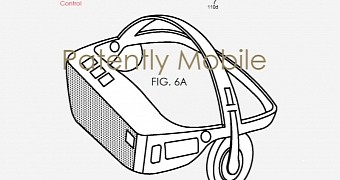During the launch event of the Pixel smartphones in early October, Google also announced the new Daydream VR headset. The Daydream View VR headset came with a controller that features motion controls and two buttons.
Daydream View works together with the Pixel and Pixel XL smartphones, and it’s made out of fabric rather than plastic. The headset is offered in three colors and weighs around 220 grams. It also comes with a replaceable face mask that can be hand-washed. The headset has a reduced number of straps and clips, and users can put it on without having to take off their glasses.
It seems that Google is contemplating a change in the headset’s design, as a recently patent application reveals. Patently Mobile found out that Google might be working on the next-generation virtual and/or augmented reality headset, as a patent application was recently filed at the US Patent & Trademark Office.
Google’s upcoming Daydream VR might have built-in headphones
The application reveals that the upcoming system will have built-in headphones for enhancing the user’s gaming and VR experience. The headset will also have more controls for adjusting the device’s lenses and lighting conditions.
In addition, it seems that Google may create an all-new VR tracking system for allowing users to wear the headset and move around in the room while playing games, so that their VR experience is more realistic. Google’s next generation headset will be able to track the user’s position in real world and perform a process for transitioning out of the virtual world generated on the platform.
The filling also shows that Google may be working on a new method of operating an audio visual system that can generate a virtual experience which may include activating a tracking device. The processor may be set to translate the detected real world movement of the user electric device into virtual movement.
The system will also be able to make users avoid obstacles in the room by using a gradual transition out of the virtual world. This is just a patent application for now, and it remains to be seen if Google will actually incorporate the technology in an upcoming Daydream VR headset.

 14 DAY TRIAL //
14 DAY TRIAL //